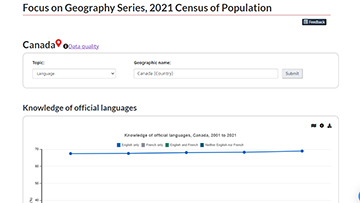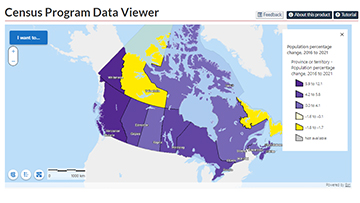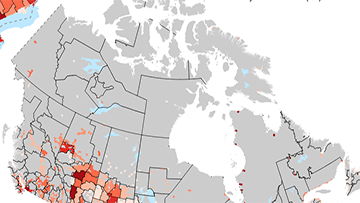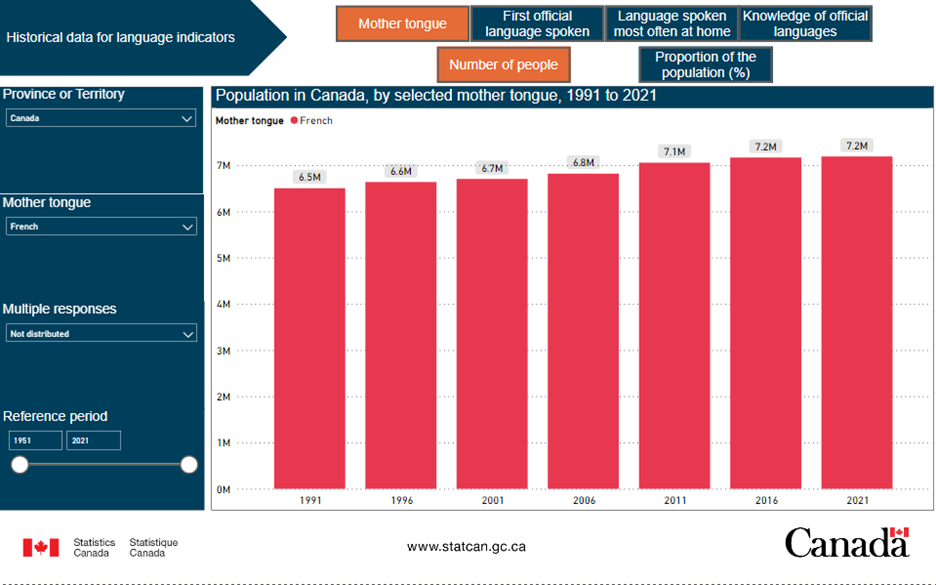Archived - Annual Exploration, Development and Capital Expenditures Survey: Petroleum and Natural Gas Industry - Preliminary Estimate for 2019 and Intentions for 2020
Why do we conduct this survey?
This survey collects data on capital and repair expenditures in Canada. The information is used by federal and provincial government departments and agencies, trade associations, universities and international organizations for policy development and as a measure of regional economic activity.
Your information may also be used by Statistics Canada for other statistical and research purposes.
Your participation in this survey is required under the authority of the Statistics Act.
Other important information
Authorization to collect this information
Data are collected under the authority of the Statistics Act, Revised Statutes of Canada, 1985, Chapter S-19.
Confidentiality
By law, Statistics Canada is prohibited from releasing any information it collects that could identify any person, business, or organization, unless consent has been given by the respondent, or as permitted by the Statistics Act. Statistics Canada will use the information from this survey for statistical purposes only.
Record linkages
To enhance the data from this survey and to reduce the reporting burden, Statistics Canada may combine the acquired data with information from other surveys or from administrative sources.
Data-sharing agreements
To reduce respondent burden, Statistics Canada has entered into data-sharing agreements with provincial and territorial statistical agencies and other government organizations, which have agreed to keep the data confidential and use them only for statistical purposes. Statistics Canada will only share data from this survey with those organizations that have demonstrated a requirement to use the data.
Section 11 of the Statistics Act provides for the sharing of information with provincial and territorial statistical agencies that meet certain conditions. These agencies must have the legislative authority to collect the same information, on a mandatory basis, and the legislation must provide substantially the same provisions for confidentiality and penalties for disclosure of confidential information as the Statistics Act. Because these agencies have the legal authority to compel businesses to provide the same information, consent is not requested and businesses may not object to the sharing of the data.
For this survey, there are Section 11 agreements with the provincial and territorial statistical agencies of Newfoundland and Labrador, Nova Scotia, New Brunswick, Quebec, Ontario, Manitoba, Saskatchewan, Alberta, British Columbia, and the Yukon.
The shared data will be limited to information pertaining to business establishments located within the jurisdiction of the respective province or territory.
Section 12 of the Statistics Act provides for the sharing of information with federal, provincial or territorial government organizations. Under Section 12, you may refuse to share your information with any of these organizations by writing a letter of objection to the Chief Statistician, specifying the organizations with which you do not want Statistics Canada to share your data and mailing it to the following address:
Chief Statistician of Canada
Statistics Canada
Attention of Director, Enterprise Statistics Division
150 Tunney's Pasture Driveway
Ottawa, Ontario
K1A 0T6
You may also contact us by email at statcan.esdhelpdesk-dsebureaudedepannage.statcan@statcan.gc.ca or by fax at 613-951-6583.
For this survey, there are Section 12 agreements with the statistical agencies of Prince Edward Island, the Northwest Territories and Nunavut as well as Environment and Climate Change Canada, Infrastructure Canada, National Energy Board and Natural Resources Canada.
For agreements with provincial and territorial government organizations, the shared data will be limited to information pertaining to business establishments located within the jurisdiction of the respective province or territory.
Business or organization and contact information
1. Verify or provide the business or organization's legal and operating name and correct where needed.
Note: Legal name modifications should only be done to correct a spelling error or typo.
Legal Name
The legal name is one recognized by law, thus it is the name liable for pursuit or for debts incurred by the business or organization. In the case of a corporation, it is the legal name as fixed by its charter or the statute by which the corporation was created.
Modifications to the legal name should only be done to correct a spelling error or typo.
To indicate a legal name of another legal entity you should instead indicate it in question 3 by selecting 'Not currently operational' and then choosing the applicable reason and providing the legal name of this other entity along with any other requested information.
Operating Name
The operating name is a name the business or organization is commonly known as if different from its legal name. The operating name is synonymous with trade name.
Legal name
Operating name (if applicable)
2. Verify or provide the contact information of the designated business or organization contact person for this questionnaire and correct where needed.
Note: The designated contact person is the person who should receive this questionnaire. The designated contact person may not always be the one who actually completes the questionnaire.
First name
Last name
Title
Preferred language of communication
- English
- French
Mailing address (number and street)
City
Province, territory or state
Postal code or ZIP code
Country
- Canada
- United States
Email address
Telephone number (including area code)
Extension number (if applicable)
The maximum number of characters is 10.
Fax number (including area code)
3. Verify or provide the current operational status of the business or organization identified by the legal and operating name above.
- Operational
- Not currently operational
Why is this business or organization not currently operational?- Seasonal operations
- When did this business or organization close for the season?
- Date
- When does this business or organization expect to resume operations?
- Date
- When did this business or organization close for the season?
- Ceased operations
- When did this business or organization cease operations?
- Date
- Why did this business or organization cease operations?
- Bankruptcy
- Liquidation
- Dissolution
- Other - Specify the other reasons for ceased operations
- When did this business or organization cease operations?
- Sold operations
- When was this business or organization sold?
- Date
- What is the legal name of the buyer?
- When was this business or organization sold?
- Amalgamated with other businesses or organizations
- When did this business or organization amalgamate?
- Date
- What is the legal name of the resulting or continuing business or organization?
- What are the legal names of the other amalgamated businesses or organizations?
- When did this business or organization amalgamate?
- Temporarily inactive but will re-open
- When did this business or organization become temporarily inactive?
- Date
- When does this business or organization expect to resume operations?
- Date
- Why is this business or organization temporarily inactive?
- When did this business or organization become temporarily inactive?
- No longer operating due to other reasons
- When did this business or organization cease operations?
- Date
- Why did this business or organization cease operations?
- When did this business or organization cease operations?
- Seasonal operations
4. Verify or provide the current main activity of the business or organization identified by the legal and operating name above.
Note: The described activity was assigned using the North American Industry Classification System (NAICS).
Note: Press the help button (?) for additional information, including a detailed description of this activity complete with example activities and any applicable exclusions.
This question verifies the business or organization's current main activity as classified by the North American Industry Classification System (NAICS). The North American Industry Classification System (NAICS) is an industry classification system developed by the statistical agencies of Canada, Mexico and the United States. Created against the background of the North American Free Trade Agreement, it is designed to provide common definitions of the industrial structure of the three countries and a common statistical framework to facilitate the analysis of the three economies. NAICS is based on supply-side or production-oriented principles, to ensure that industrial data, classified to NAICS, are suitable for the analysis of production-related issues such as industrial performance.
The target entity for which NAICS is designed are businesses and other organizations engaged in the production of goods and services. They include farms, incorporated and unincorporated businesses and government business enterprises. They also include government institutions and agencies engaged in the production of marketed and non-marketed services, as well as organizations such as professional associations and unions and charitable or non-profit organizations and the employees of households.
The associated NAICS should reflect those activities conducted by the business or organizational units targeted by this questionnaire only, as identified in the 'Answering this questionnaire' section and which can be identified by the specified legal and operating name. The main activity is the activity which most defines the targeted business or organization's main purpose or reason for existence. For a business or organization that is for-profit, it is normally the activity that generates the majority of the revenue for the entity.
The NAICS classification contains a limited number of activity classifications; the associated classification might be applicable for this business or organization even if it is not exactly how you would describe this business or organization's main activity.
Please note that any modifications to the main activity through your response to this question might not necessarily be reflected prior to the transmitting of subsequent questionnaires and as a result they may not contain this updated information.
The following is the detailed description including any applicable examples or exclusions for the classification currently associated with this business or organization.
Description and examples
- This is the current main activity
- This is not the current main activity
Provide a brief but precise description of this business or organization's main activity.
e.g., breakfast cereal manufacturing, shoe store, software development
Main activity
5. You indicated that is not the current main activity.
Was this business or organization's main activity ever classified as: ?
- Yes
When did the main activity change?
Date - No
6. Search and select the industry classification code that best corresponds to this business or organization's main activity.
How to search:
- if desired, you can filter the search results by first selecting this business or organization's activity sector
- enter keywords or a brief description that best describes this business or organization main activity
- press the Search button to search the database for an activity that best matches the keywords or description you provided
- then select an activity from the list.
Select this business or organization's activity sector (optional)
- Farming or logging operation
- Construction company or general contractor
- Manufacturer
- Wholesaler
- Retailer
- Provider of passenger or freight transportation
- Provider of investment, savings or insurance products
- Real estate agency, real estate brokerage or leasing company
- Provider of professional, scientific or technical services
- Provider of health care or social services
- Restaurant, bar, hotel, motel or other lodging establishment
- Other sector
7. You have indicated that the current main activity of this business or organization is:
Main activity
Are there any other activities that contribute significantly (at least 10%) to this business or organization's revenue?
- Yes, there are other activities
Provide a brief but precise description of this business or organization's secondary activity
e.g., breakfast cereal manufacturing, shoe store, software development - No, that is the only significant activity
8. Approximately what percentage of this business or organization's revenue is generated by each of the following activities?
When precise figures are not available, provide your best estimates.
| Percentage of revenue | |
|---|---|
| Main activity | |
| Secondary activity | |
| All other activities | |
| Total percentage |
Reporting period information
1. What are the start and end dates of this organization's 2019 fiscal year?
Note: For this survey, the end date should fall between April 1, 2019 and March 31, 2020.
Press the help button (?) for additional information, including examples of reporting periods.
Here are twelve common fiscal periods that fall within the targeted dates:
- May 1, 2018 to April 30, 2019
- June 1, 2018 to May 31, 2019
- July 1, 2018 to June 30, 2019
- August 1, 2018 to July 31, 2019
- September 1, 2018 to August 31, 2019
- October 1, 2018 to September 30, 2019
- November 1, 2018 to October 31, 2019
- December 1, 2018 to November 30, 2019
- January 1, 2019 to December 31, 2019
- February 1, 2019 to January 31, 2020
- March 1, 2019 to February 28, 2020
- April 1, 2019 to March 31, 2020.
Here are other examples of fiscal periods that fall within the required dates:
- September 18, 2018 to September 15, 2019 (e.g., floating year-end)
- June 1, 2019 to December 31, 2019 (e.g., a newly opened business).
Fiscal Year Start date
Fiscal Year-End date
2. What is the reason the reporting period does not cover a full year?
Select all that apply.
- Seasonal operations
- New business
- Change of ownership
- Temporarily inactive
- Change of fiscal year
- Ceased operations
- Other reason - specify:
Additional reporting instructions
3. Throughout this questionnaire, please report financial information in thousands of Canadian dollars.
For example, an amount of $763,880.25 should be reported as:
CAN$ '000
I will report in the format above
Capital Expenditures - Preliminary Estimate 2019
1. For the 2019 fiscal year, what are this organization's preliminary estimates for capital expenditures?
Include: all capitalized overhead and capitalized interest.
- When there are partnerships and joint venture activities or projects, report the expenditures reflecting this corporation's net interest in such projects or ventures.
- Report all dollar amounts in thousands of Canadian dollars ('000).
- Exclude sales tax.
- When precise figures are not available, please provide your best estimates.
If there are no capital expenditures, please enter '0'.
A. Oil and gas rights acquisition and retention costs (exclude inter-company sales or transfers):
Include acquisition costs and fees for oil and gas rights (include bonuses, legal fees and filing fees), and oil and gas retention costs.
B. Exploration and evaluation, capitalized or expensed (e.g., leases and licences, seismic, exploration drilling):
These expenditures include mineral rights fees and retention costs, geological, geophysical and seismic expenses, exploration drilling, and other costs incurred during the reporting period in order to determine whether oil or gas reserves exist and can be exploited commercially. Report gross expenditures, before deducting any incentive grants, incurred for oil and gas activities on a contracted basis and/or by your own employees. Exclude the cost of land acquired from other oil and gas companies.
C. Building construction (e.g., process building, office building, camp, storage building, and maintenance garage):
Include capital expenditures on buildings such as office buildings, camps, warehouses, maintenance garages, workshops, and laboratories. Fixtures, facilities and equipment that are integral parts of the building are included.
D. Other construction assets (e.g., development drilling and completions, processing facilities, natural gas plants, upgraders):
Include all infrastructure, other than buildings, such as the cost of well pads, extraction and processing infrastructure and plants, upgrading units, transportation infrastructure, water and sewage infrastructure, tailings, pipelines and wellhead production facilities (pumpjacks, separators, etc.). Include all preconstruction planning and design costs such as development drilling, regulatory approvals, environmental assessments, engineering and consulting fees and any materials supplied to construction contractors for installation, as well as site clearance and preparation. Equipment which is installed as an integral or built-in feature of a fixed structure (e.g., casings, tanks, steam generators, pumps, electrical apparatus, separators, flow lines, etc.) should be reported with the construction asset; however, when the equipment is replaced within an existing structure, the replacement cost should be reported in machinery and equipment (sustaining capital).
E. Machinery and equipment purchases (e.g., trucks, shovels, computers, etc.):
Include transportation equipment for people and materials, computers, software, communication equipment, and processing equipment not included in the above categories.
| Intentions 2020 ( CAN$ '000 ) |
|
|---|---|
| Oil and gas rights acquisitions and retention costs | |
| Exploration and evaluation | |
| Non-residential building construction | |
| Development and other construction | |
| Machinery and equipment | |
| Total |
Research and Development
2. For the 2019 fiscal year, did this organization perform scientific research and development in Canada of at least $10,000 or outsource (contract-out) to another organization scientific research and development activities of at least $10,000?
Research and experimental development (R&D) comprise creative and systematic work undertaken in order to increase the stock of knowledge - including knowledge of humankind, culture and society - and to devise new applications of available knowledge. For an activity to be an R&D activity, it must satisfy five core criteria:
- To be aimed at new findings (novel);
- To be based on original, not obvious, concepts and hypothesis (creative);
- To be uncertain about the final outcome (uncertainty);
- To be planned and budgeted (systematic);
- To lead to results to could be possibly reproduced (transferable/ or reproducible).
The term R&D covers three types of activity: basic research, applied research and experimental development. Basic research is experimental or theoretical work undertaken primarily to acquire new knowledge of the underlying foundations of phenomena and observable facts, without any particular application or use in view. Applied research is original investigation undertaken in order to acquire new knowledge. It is, however, directed primarily towards a specific, practical aim or objective. Experimental development is systematic work, drawing on knowledge gained from research and practical experience and producing additional knowledge, which is directed to producing new products or processes or to improving existing products or processes.
- Yes
- No
Capital Expenditures - Intentions 2020
3. For the 2020 fiscal year, what are this organization's intentions for capital expenditures?
Include: all capitalized overhead and capitalized interest.
- When there are partnerships and joint venture activities or projects, report the expenditures reflecting this corporation's net interest in such projects or ventures.
- Report all dollar amounts in thousands of Canadian dollars ('000).
- Do not include sales tax.
- Percentages should be rounded to whole numbers.
- When precise figures are not available, please provide your best estimates.
If there are no capital expenditures, please enter '0'.
A. Oil and gas rights acquisition and retention costs (exclude inter-company sales or transfers):
Include acquisition costs and fees for oil and gas rights (include bonuses, legal fees and filing fees), and oil and gas retention costs
B. Exploration and evaluation, capitalized or expensed (e.g., leases and licences, seismic, exploration drilling):
These expenditures include mineral rights fees and retention costs, geological, geophysical and seismic expenses, exploration drilling, and other costs incurred during the reporting period in order to determine whether oil or gas reserves exist and can be exploited commercially. Report gross expenditures, before deducting any incentive grants, incurred for oil and gas activities on a contracted basis and/or by your own employees. Exclude the cost of land acquired from other oil and gas companies.
C. Building construction (e.g., process building, office building, camp, storage building, and maintenance garage):
Include capital expenditures on buildings such as office buildings, camps, warehouses, maintenance garages, workshops, and laboratories. Fixtures, facilities and equipment that are integral parts of the building are included.
D. Other construction assets (e.g., development drilling and completions, processing facilities, natural gas plants, upgraders):
Include all infrastructure, other than buildings, such as the cost of well pads, extraction and processing infrastructure and plants, upgrading units, transportation infrastructure, water and sewage infrastructure, tailings, pipelines and wellhead production facilities (pumpjacks, separators, etc.). Include all preconstruction planning and design costs such as development drilling, regulatory approvals, environmental assessments, engineering and consulting fees and any materials supplied to construction contractors for installation, as well as site clearance and preparation. Equipment which is installed as an integral or built-in feature of a fixed structure (e.g., casings, tanks, steam generators, pumps, electrical apparatus, separators, flow lines, etc.) should be reported with the construction asset; however, when the equipment is replaced within an existing structure, the replacement cost should be reported in machinery and equipment (sustaining capital).
E. Machinery and equipment purchases (e.g., trucks, shovels, computers, etc.):
Include transportation equipment for people and materials, computers, software, communication equipment, and processing equipment not included in the above categories.
| 2019 Preliminary Estimate ( CAN$ '000 ) |
|
|---|---|
| Oil and gas rights acquisitions and retention costs | |
| Exploration and evaluation | |
| Non-residential building construction | |
| Development and other construction | |
| Machinery and equipment | |
| Total |
In order to reduce future follow-up, please select one of the following options.
You could also make corrections to the current cycle by pressing the Previous button.
You have not reported anything for 2020, but have entered data for 2019. Is this correct? If you do not intend on having any capital expenditures in the 2020 fiscal year, please return to the previous page and enter `0`s. If this information is not yet available, please press the Next button.
- I confirm that all values are correct.
- I am unable to confirm that all values are correct.
Research and Development
4. For the 2020 fiscal year, does this organization plan on performing scientific research and development in Canada of at least $10,000 or outsourcing (contracting-out) to another organization scientific research and development activities of at least $10,000?
Research and experimental development (R&D) comprise creative and systematic work undertaken in order to increase the stock of knowledge - including knowledge of humankind, culture and society - and to devise new applications of available knowledge. For an activity to be an R&D activity, it must satisfy five core criteria:
- To be aimed at new findings (novel);
- To be based on original, not obvious, concepts and hypothesis (creative);
- To be uncertain about the final outcome (uncertainty);
- To be planned and budgeted (systematic);
- To lead to results to could be possibly reproduced (transferable/ or reproducible).
The term R&D covers three types of activity: basic research, applied research and experimental development. Basic research is experimental or theoretical work undertaken primarily to acquire new knowledge of the underlying foundations of phenomena and observable facts, without any particular application or use in view. Applied research is original investigation undertaken in order to acquire new knowledge. It is, however, directed primarily towards a specific, practical aim or objective. Experimental development is systematic work, drawing on knowledge gained from research and practical experience and producing additional knowledge, which is directed to producing new products or processes or to improving existing products or processes.
- Yes
- No
Notification of intent to extract web data
5. Does this business have a website?
- Yes
Specify the business website address
e.g., www.example.ca - No
Statistics Canada is piloting a web data extraction initiative, also known as web scraping, which uses software to search and compile publicly available data from organizational websites. As a result, we may visit the website for this organization to search for, and compile, additional information. This initiative should allow us to reduce the reporting burden on organizations, as well as produce additional statistical indicators to ensure that our data remain accurate and relevant.
We will do our utmost to ensure the data are collected in a manner that will not affect the functionality of the website. Any data collected will be used by Statistics Canada for statistical and research purposes only, in accordance with the agency's mandate.
For more information regarding Statistics Canada's web scraping initiative, please visit About us.
To learn more about Statistics Canada's transparency and accountability, please visit Transparency and accountability.
If you have any questions or concerns, please contact Statistics Canada Client Services, toll-free at 1-877-949-9492 (TTY: 1-800-363-7629) or by email at infostats@canada.ca. For more information regarding this survey, please visit Information for survey participants (ISP).
Changes or events
1. Indicate any changes or events that affected the reported values for this business or organization, compared with the last reporting period.
Select all that apply.
- Strike or lock-out
- Exchange rate impact
- Price changes in goods or services sold
- Contracting out
- Organizational change
- Price changes in labour or raw materials
- Natural disaster
- Recession
- Change in product line
- Sold business or business units
- Expansion
- New or lost contract
- Plant closures
- Acquisition of business or business units
- Other - Specify the other changes or events:
- No changes or events
Contact person
1. Statistics Canada may need to contact the person who completed this questionnaire for further information.
Is [Provided Given Names] , [Provided Family Name] the best person to contact?
- Yes
- No
Who is the best person to contact about this questionnaire?
First name:
Last name:
Title:
Email address:
Telephone number (including area code):
Extension number (if applicable):
The maximum number of characters is 5.
Fax number (including area code):
Feedback
1. How long did it take to complete this questionnaire?
Include the time spent gathering the necessary information.
Hours:
Minutes:
2. Do you have any comments about this questionnaire?

 Business and consumer services
Business and consumer services Culture
Culture Other content related to business and consumer services and culture
Other content related to business and consumer services and culture







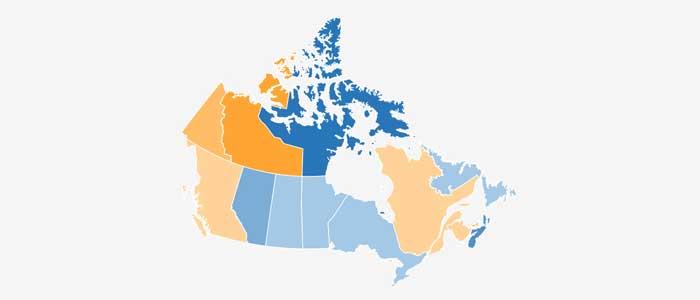



 Knowledge of languages
Knowledge of languages Language groups
Language groups Use of languages
Use of languages Other content related to Languages
Other content related to Languages








